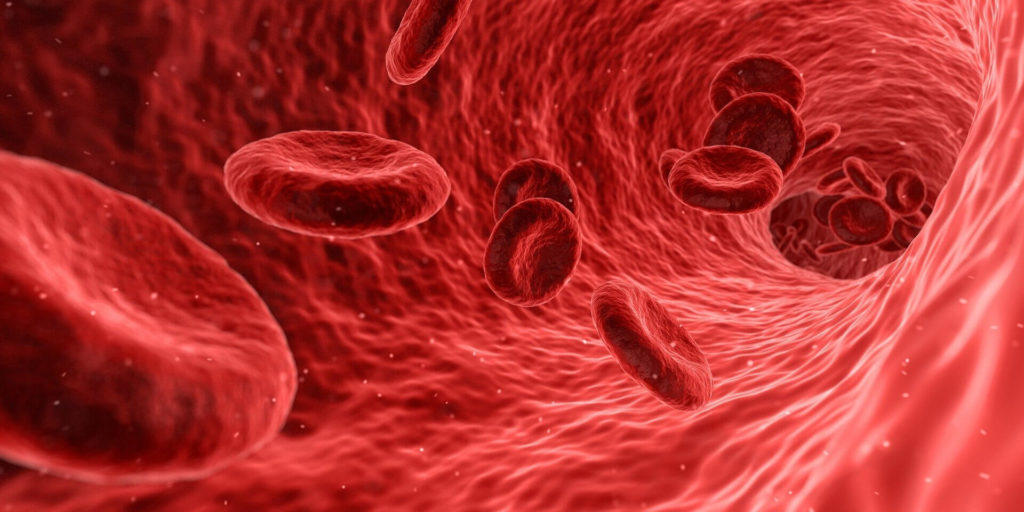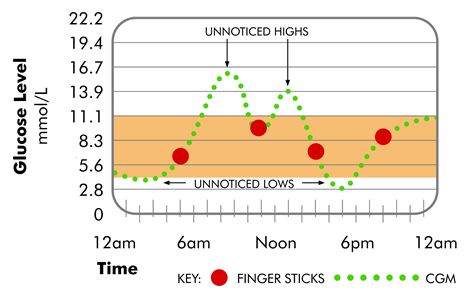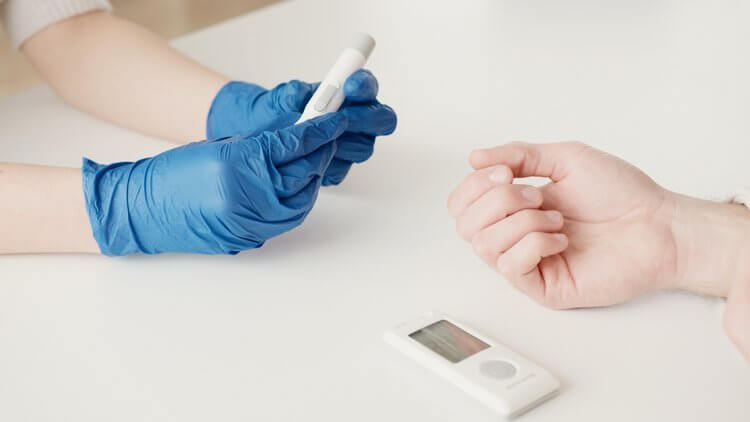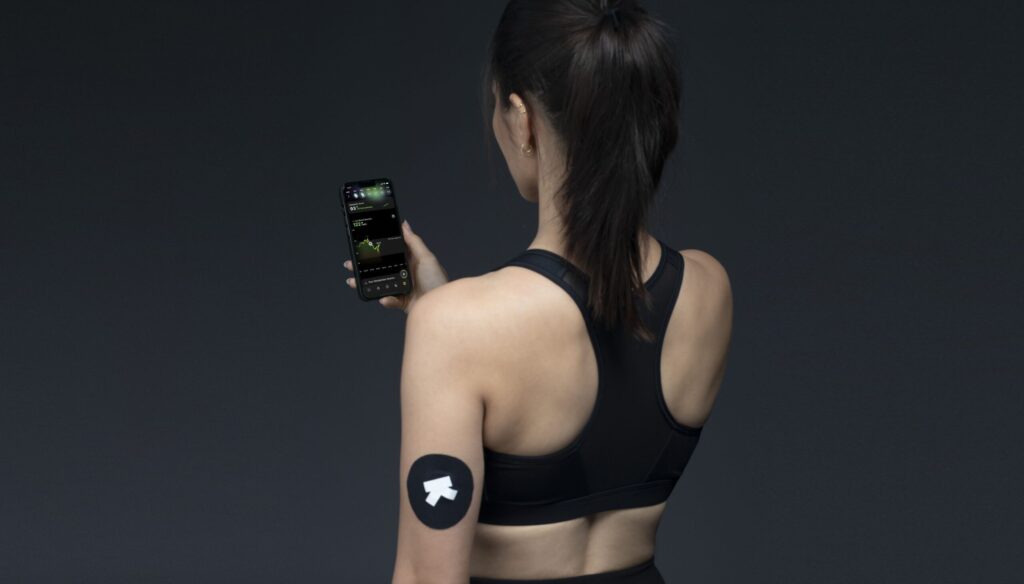Glucose is critical to the healthy functioning of our bodies. Glucose levels naturally oscillate through the course of the day, but it’s the extent of the fluctuation that matters. High glucose variability, or unsteady blood sugar levels, are associated with metabolic dysfunction, diabetes and cardiovascular complications. Both high and low blood glucose levels can be detrimental in the long run. Our glucose levels function as a stream of information that offers insights into our overall health.

Highlights
- What is interstitial fluid and what are how will the glucose readings through interstitial fluid help,
- Glucose readings through blood glucose metres,
- Time lag for interstitial fluid and its importance.
Monitoring our blood glucose levels is the first step toward regulating them. Tracking our blood glucose levels can help us correct our course and make changes in our fitness or fueling routine with the aid of nutrition and healthcare professionals. People generally measure their blood glucose levels with a glucose metre or through an HbA1c test in a lab. Continuous glucose monitoring (CGM) devices do just that, by deploying tiny sensors that are worn either on the tricep or the stomach to monitor glucose levels of the interstitial fluid. The results can be assessed live on an app or via a receiver.
What is Interstitial Fluid?
Interstitial fluid is the liquid that fills spaces between cells. It is made up of water, amino acids, sugars, fatty acids, coenzymes, hormones, neurotransmitters, salts and cellular products. The interstitial fluid surrounds and bathes every cell of the body. It is responsible for bringing oxygen and other nutrients into the body’s cells and helps to remove waste products from them. When new fluid replaces the old fluid, it drains to the lymph vessels and becomes tissue fluid, also known as lymph. Interstitial fluid is similar to blood plasma since the two continuously exchange substances across capillary walls. However, blood plasma is confined to only the blood vessels.
Glucose readings through Interstitial fluid
CGM devices are active throughout the day and night. They monitor the level of glucose within the interstitial fluid, as opposed to glucose in the blood. This differs from glucose metre readings, which detect the level of glucose in a person’s blood following a pinprick test. Applying a drop of blood to a test strip yields an instant result.
By monitoring interstitial glucose levels over long periods of time, results can show themes or trends which spike glucose levels. These spikes in glucose levels can follow the consumption of specific meals or medications as well as exercise. One can even gauge the impact of stress and sleep on glucose levels.

The interstitial fluid is the fluid between blood vessels and the cells of the body. It conveys oxygen and nutrients to the cells. Blood helps transport glucose to the body’s cells. From the blood, glucose moves freely and directly via a concentration gradient into the interstitial fluid. (Concentration gradient is the difference in the concentration of a substance between two areas).
Once glucose enters the interstitial fluid, it is transported into the body’s cells. Upon entering a cell (such as a muscle cell), it becomes ‘trapped’ and is not able to return to the interstitial fluid or the bloodstream. The movement of glucose from the blood to the interstitial fluid can be influenced by multiple factors such as the metabolic rate of surrounding cells and insulin sufficiency.
There is a small delay when checking fluid readings, especially after eating or exercise, known as a ‘time lag’. A time lag is simply the period of time in which blood glucose transitions between the bloodstream into the interstitial fluid. This can range anywhere between 5-25 minutes and is the reason why a pinprick test taken directly after eating or exercising will show a different result to a CGM reading.
Glucose reading through Blood Glucose metre
Blood glucose concentration is a marker of the total current available glucose in the blood. Blood glucose fluctuates throughout the day, particularly after eating a meal. Studies suggest that there is around a 20mg/dL difference between arterial and venous blood glucose.
Capillary blood glucose levels at the fingertip (fingerpick test) have been shown to correlate well with systemic arterial blood glucose levels. However, there are variables (mainly due to blood flow variability), hence levels from alternate sites differ considerably. For instance, the blood glucose reading measured from the forearm is generally lower than the fingertip at times of rapid increase (i.e., postprandial rise in blood glucose or following exercise) in systemic blood (blood which provides the cells with nutrients and oxygen) and higher in rapid decreases.

Basic differences between the two forms of measurement
Interstitial fluid glucose changes are measured by CGM devices in a small volume of tissue around the tip of the glucose sensor, which undergoes relatively slower changes in glucose levels. Comparing blood glucose measurements with interstitial CGM recordings (in the case of stable glucose levels) shows relatively identical glucose values. However, when there is a rapid change in glucose levels, such as during/after exercise, results can differ considerably between blood glucose and interstitial fluid glucose levels.
The assumption by most users of CGM systems (and diabetologists) is that these differences are short-lived and not pronounced enough to be of significant therapeutic relevance. The technology that supports using interstitial fluid to monitor glucose levels in non-diabetic persons such as CGM is still in its early stages. More studies need to be conducted in order to determine whether CGM or CGM readings combined with blood glucose monitoring give a more accurate reading of glucose values.
Time lag for Interstitial Fluid
Glucose in the blood takes time to make its way to the interstitial fluid so there may be a lag in time. After a meal, a rise in blood glucose is induced by glucose uptake in the intestines. However, this is not accompanied by a rise in interstitial fluid glucose simultaneously because there is a reported time lag of around 5 to 25 minutes.
This time lag can be explained by the gradient in glucose which increases in the blood, differing depending on the type and quantity of carbohydrates in a given meal. With a high glucose load and rapidly absorbable carbohydrates (also known as simple carbohydrates), there is a steeper increase in blood glucose. Some studies suggest that if patients use the interstitial fluid glucose value 60 minutes after starting a meal, it may not correlate with the blood glucose value, which would be significantly higher if measured.
Unlike blood glucose, changes in interstitial fluid are subject to sensitive dynamics of muscle metabolism. Muscle metabolism is the amount of energy required by the cells in the muscles. For example, more energy/glucose will be required by the cells during times of exercise.
According to the officially approved guidelines set by regulatory authorities, CGM readings should not be used to determine insulin doses for those with diabetes as CGM readings often do not correspond exactly to self-monitoring of blood glucose (SMBG) measurement results taken at the same time, especially during fast changes in blood glucose.
Why do we use Blood Glucose metres?
Blood glucose monitoring is used to measure and display the amount of glucose in the blood. Blood glucose can frequently fluctuate for multiple reasons such as exercise, food, medications and stress. Therefore, being able to monitor glucose levels with the convenience of a portable and instantaneous pinprick test allows for the prevention of complications that can arise when blood glucose levels are not stable.
Blood Glucose Metres Can Help With The Following
- Identify blood sugar levels that are high or low, preventing hypoglycemic or hyperglycemic episodes.
- Track the impact of certain activities and particular foods on our glucose levels.
- Stable blood glucose levels also help to maintain steady energy levels, and good skin and even take care of our brain and mental health beyond our metabolic health.
- Manage risk factors like inflammation that are associated with serious ailments like cancer, type 2 diabetes and Alzheimer’s disease.
- Elevated blood glucose can damage blood vessels and nerves that regulate the healthy functioning of the heart, and also increase the chances of developing hypertension. Chronic hypertension increases the force of blood through your arteries and can damage artery walls over time.
- Hypoglycemia is as problematic as high blood glucose levels, especially because it goes undetected often. Individuals with hypoglycemia unawareness are unable to detect their symptoms on time and address them.
Conclusion
Blood glucose and interstitial fluid glucose levels fluctuate throughout the day for various reasons such as exercise, stress, medications and food consumption. Continuous glucose monitoring (CGM) devices monitor the level of glucose within the interstitial fluid as opposed to blood glucose, which instead can be observed through glucose metres (pinprick testing). CGM devices are worn under the skin of the arm or stomach, are active throughout the day and night and provide summaries of daily trends that may be causing spikes in blood glucose. Those with diabetes will be recommended to monitor their blood glucose levels daily. However, there are benefits to monitoring glucose levels for those who are not diabetic also.
Finger prick tests have been shown to correlate well with systemic arterial blood glucose levels, allowing for the prevention of complications. However, variables like blood flow variability, meaning blood glucose levels from alternate sites (i.e., finger vs. forearm) differ considerably. Glucose concentration in the interstitial fluid depends more on local conditions like how much glucose diffuses from the blood into the interstitial fluid and how much is metabolised by the metabolically active tissues nearby. Comparing blood glucose measurements with interstitial CGM recordings in healthy individuals shows relatively identical glucose values.
Disclaimer: The contents of this article are for general information and educational purposes only. It neither provides any medical advice nor intends to substitute professional medical opinion on the treatment, diagnosis, prevention or alleviation of any disease, disorder or disability. Always consult with your doctor or qualified healthcare professional about your health condition and/or concerns and before undertaking a new health care regimen including making any dietary or lifestyle changes.
References








